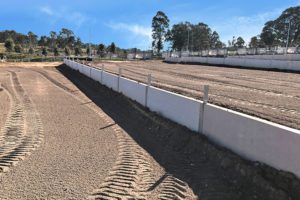A Sunshine Coast developer who secured an agreement with his neighbour for a retaining wall to be constructed “on the boundary,” has been ordered by a court to remove it, because it wasn’t constructed entirely within his land.
Noel Covey’s company acquired the Buderim development site in mid-2019.
 It adjoined a property owned by Theo and Maria Andre Paridaen – a battleaxe block – whose access to Somerset Drive was down a 70 m driveway that also provided access for their neighbour, Mr Moore.
It adjoined a property owned by Theo and Maria Andre Paridaen – a battleaxe block – whose access to Somerset Drive was down a 70 m driveway that also provided access for their neighbour, Mr Moore.
Covey notified the Paridaens in September 2019 that the subdivision works for which he was expecting to receive council approval, required the construction of a 60 cm high rock wall along the entire length of the existing driveway “and contained within our property”.
Paridaen – concerned about the potential impact to his holding – conducted a survey and provided a copy to Covey.
The plans approved by the Sunshine Coast Council in January 2020 conditioned the wall to be built “to the boundary” of the subject land.
Then in April, the adjoining owners entered into a written agreement allowing the wall to be built “on the boundary….at the developer’s sole risk” with the latter liable to indemnify the Paridaens against any liability or loss for a breach of the agreement by the developer.
The constructed retaining wall encroaches as much as 10cm to 13 cm into the Paridaens’ property – impinging on the 6m driveway width – and occupies about 5m2 of their land.
Covey lodged the plan of survey for registration in July despite knowing that the retaining wall was not contained within the lot as the DA conditions required.
Discussions between the neighbours went nowhere. The Paridaens eventually filed an Originating Application in the Supreme Court pursuant to s 182 of the Property Law Act in January 2022, for removal of encroachment.
The reference in the deed to the retaining wall being “on” the boundary meant – they contended – it would not traverse the boundary onto his property.
Chief Justice Helen Bowskill had to determine by reference to the factors set out in s 185, whether to exercise her discretion to require it to be removed or alternatively, to require payment for the grant of an easement.
Relevant factors – she observed – were whether a survey was obtained at an early stage; the conduct of the parties giving rise to the encroachment and whether the encroaching owner was aware of the issue during construction.
In her view, a reasonable person would understand the words “on the boundary” to refer to the rock wall being constructed on Covey’s land “up to but not beyond the common boundary”.
“The words ‘on the common boundary’ are in the context of the Deed as a whole to be understood as meaning ‘to’ the common boundary,” she ruled.
The context on which she relied included Covey’s earlier reference to a proposed rock wall ‘contained within our property’; his receipt of a copy of the survey the neighbours had arranged before any work commenced; the development approval expressly requiring the wall be wholly contained within Covey’s lot; and the absence of any provision for compensation for an easement or an adjustment to the boundary.
Taking a “less than favourable view” of Covey’s credibility, she concluded it to have been “entirely implausible” that the Paridaens would have agreed to the rock wall being constructed on their land.
Acknowledging the minor extent of the encroachment and the significant rectification cost of up to $100k, she nevertheless ordered that Covey remove the wall as he had allowed the work to be done knowing such outcome was not permitted.
“The encroachment may not be significant to the respondent, but on the evidence of Mr Paridaen, which I accept, it is clearly significant to the applicants”.
Covey’s company was also ordered to pay his neighbour’s legal costs of the removal of encroachment dispute.
Paridaen & Anor v Mahaside Pty Ltd [2022] QSC 109 Bowskill CJ, 2 June 2022




0 Comments